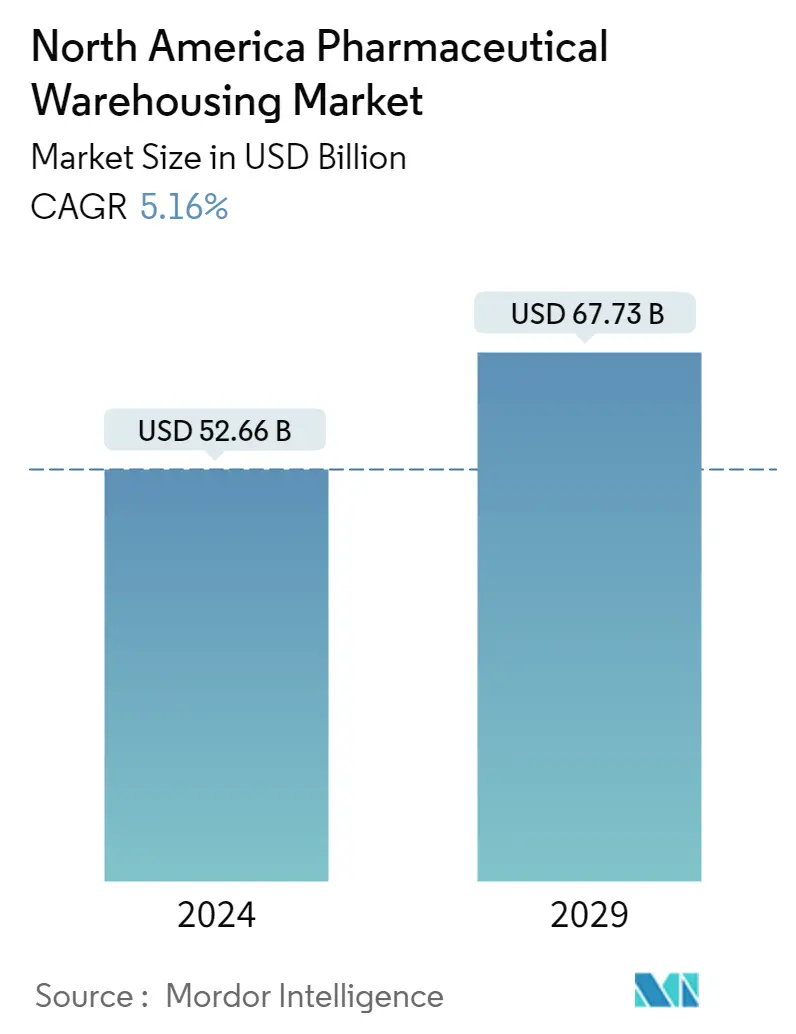Market Size of North America Pharmaceutical Warehousing Industry

| Study Period | 2019 - 2029 |
| Base Year For Estimation | 2023 |
| Market Size (2024) | USD 52.66 Billion |
| Market Size (2029) | USD 67.73 Billion |
| CAGR (2024 - 2029) | 5.16 % |
| Market Concentration | Low |
Major Players
*Disclaimer: Major Players sorted in no particular order |
North America Pharmaceutical Warehousing Market Analysis
The North America Pharmaceutical Warehousing Market size is estimated at USD 52.66 billion in 2024, and is expected to reach USD 67.73 billion by 2029, growing at a CAGR of 5.16% during the forecast period (2024-2029).
The North American pharmaceutical warehousing market plays a pivotal role in the healthcare supply chain, influenced by stringent regulatory mandates and the evolving intricacies of pharmaceutical products. The U.S. Food and Drug Administration (FDA) enforces Good Manufacturing Practices (GMP), emphasizing strict temperature controls, efficient stock rotation, and robust traceability systems to uphold pharmaceutical integrity. A September 2023 FDA report highlighted that over 80% of U.S. facilities storing vaccines and biologics were equipped with specialized cold-chain storage, underscoring the U.S.'s stature as a leading pharmaceutical manufacturer .
In the U.S., technological innovations are transforming pharmaceutical warehousing. Most large warehouses now standardize real-time monitoring for temperature and humidity, ensuring adherence to FDA guidelines. The International Trade Administration (ITA) reported in October 2023 that U.S. pharmaceutical exports, notably high-value biologics, hit USD 88 billion, underscoring the pressing demand for secure and compliant warehousing. Furthermore, blockchain technology is being harnessed to bolster traceability, particularly for oncology drugs and gene therapies necessitating ultra-low storage, often dipping below -70°C. Since April 2023, IBM's pilot program has integrated blockchain to monitor temperature-sensitive pharmaceuticals, ensuring secure handling and mitigating counterfeit risks.
Canada’s pharmaceutical warehousing market is witnessing notable growth, bolstered by Health Canada’s GMP regulations. Statistics Canada, in January 2024, noted a 12% year-on-year surge in demand for cold-chain solutions, spurred by rising biologics imports and a governmental push to bolster domestic vaccine production . With over 70% of Canada's pharmaceutical exports heading to the U.S. (USD 6.74 billion), cross-border trade underscores the necessity for seamless regulatory compliance. This uptick in demand for temperature-sensitive storage further cements Canada's expanding role in North America's pharmaceutical landscape.
North America Pharmaceutical Warehousing Industry Segmentation
Pharmaceutical warehousing refers to the systematic storage of medicinal products and related items. It is used in the pharmaceutical industry to store active ingredients and other volatile substances that need to be stored in a controlled environment to be safe and effective.
The report provides a comprehensive background analysis of the North America Pharmaceutical Warehousing Market, covering the current market trends, market dynamics, technological updates, and detailed information on various segments and the industry’s competitive landscape.
The North America pharmaceutical Warehousing Market is segmented by type (cold chain warehouses and non-cold chain warehouses), application (pharmaceutical factory, pharmacy, hospital, and others), and country (United States, Canada, and Mexico). The report offers market size and forecasts for the North American pharmaceutical Warehousing Market in value (USD) for all the above segments.
| By Type | |
| Cold Chain Warehouses | |
| Non-Cold Chain Warehouses |
| By Application | |
| Pharmaceutical Factory | |
| Pharmacy | |
| Hospital | |
| Others |
| By Geography | |
| United States | |
| Canada | |
| Mexico |
North America Pharmaceutical Warehousing Market Size Summary
The North America Pharmaceutical Warehousing Market is poised for significant growth, driven by advancements in technology and increasing demand for pharmaceuticals. The integration of IoT, blockchain, and data analytics is enhancing supply chain visibility and efficiency, while the rise in cold chain logistics is improving the safety and connectivity of pharmaceutical transportation. The market's expansion is closely tied to the pharmaceutical manufacturing sector and consumer spending trends, with manufacturers increasing their warehouse space to accommodate higher production levels. The COVID-19 pandemic highlighted the need for more robust inventory strategies, leading to a shift from lean manufacturing to maintaining buffer stocks. This shift, along with the growing trend of outsourcing logistics operations, is expected to sustain the market's growth trajectory.
The market is characterized by a high degree of fragmentation, with numerous international and local logistics companies competing to offer secure and efficient supply chain solutions. Major players are actively pursuing strategic alliances, mergers, and acquisitions to enhance their market presence and technological capabilities. The increasing pharmaceutical trade, particularly between the United States and Mexico, further fuels the demand for warehousing solutions. Additionally, the rise of e-commerce and app-based pharmacies in North America is driving the need for well-positioned distribution centers to ensure quick and efficient product delivery. As the industry continues to evolve with new technologies and cost-effective manufacturing processes, the North American pharmaceutical warehousing market is expected to experience sustained growth.
North America Pharmaceutical Warehousing Market Size - Table of Contents
-
1. MARKET INSIGHTS
-
1.1 Market Overview
-
1.2 Industry Policies and Regulations
-
1.3 Government Regulations and Initiatives
-
1.4 Supply Chain/Value Chain Analysis
-
1.5 Insights into Technological Innovation in the Events Logistics Sector
-
1.6 Impact of Geopolitics and Pandemic on the Market
-
-
2. MARKET SEGMENTATION
-
2.1 By Type
-
2.1.1 Cold Chain Warehouses
-
2.1.2 Non-Cold Chain Warehouses
-
-
2.2 By Application
-
2.2.1 Pharmaceutical Factory
-
2.2.2 Pharmacy
-
2.2.3 Hospital
-
2.2.4 Others
-
-
2.3 By Geography
-
2.3.1 United States
-
2.3.2 Canada
-
2.3.3 Mexico
-
-
North America Pharmaceutical Warehousing Market Size FAQs
How big is the North America Pharmaceutical Warehousing Market?
The North America Pharmaceutical Warehousing Market size is expected to reach USD 52.66 billion in 2024 and grow at a CAGR of 5.16% to reach USD 67.73 billion by 2029.
What is the current North America Pharmaceutical Warehousing Market size?
In 2024, the North America Pharmaceutical Warehousing Market size is expected to reach USD 52.66 billion.

